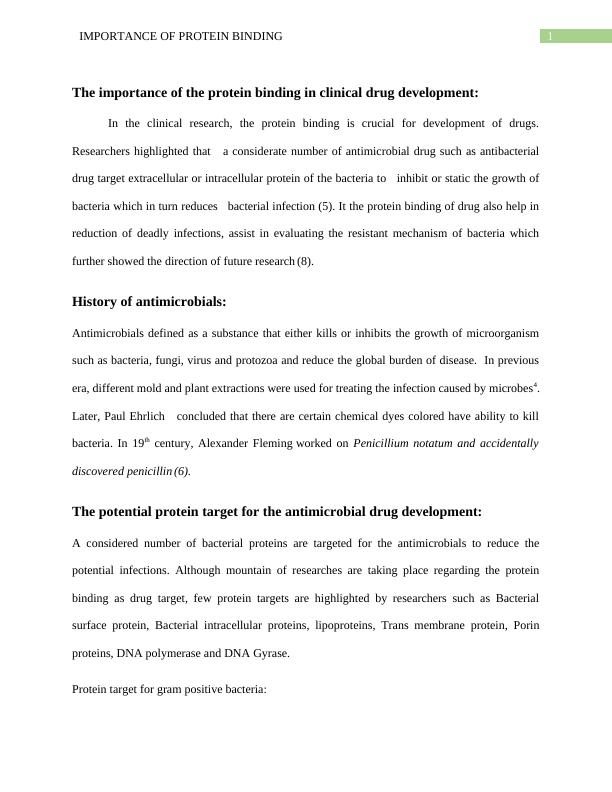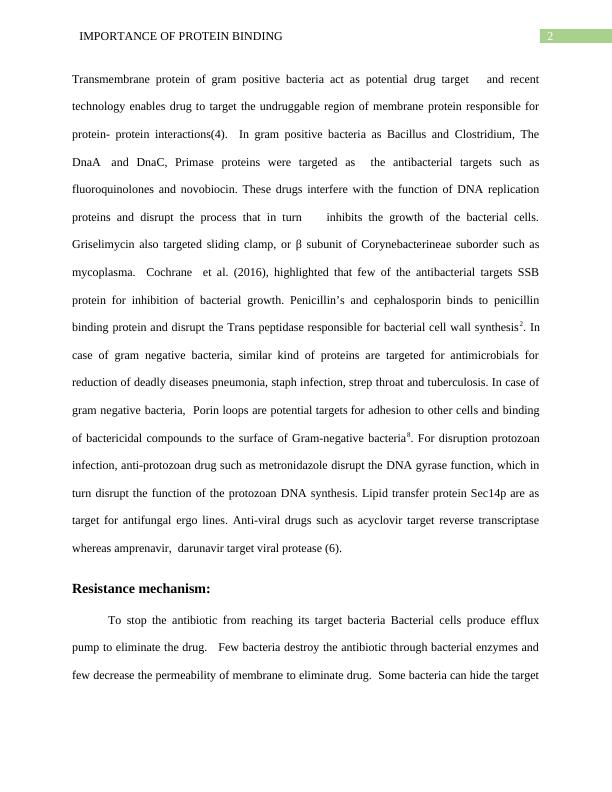Importance of Protein Binding in Clinical Drug Development
Added on 2023-04-25
7 Pages1296 Words445 Views
Running head: IMPORTANCE OF PROTEIN BINDING
Name of the student
Name of the university
Author note:
Name of the student
Name of the university
Author note:

1IMPORTANCE OF PROTEIN BINDING
The importance of the protein binding in clinical drug development:
In the clinical research, the protein binding is crucial for development of drugs.
Researchers highlighted that a considerate number of antimicrobial drug such as antibacterial
drug target extracellular or intracellular protein of the bacteria to inhibit or static the growth of
bacteria which in turn reduces bacterial infection (5). It the protein binding of drug also help in
reduction of deadly infections, assist in evaluating the resistant mechanism of bacteria which
further showed the direction of future research (8).
History of antimicrobials:
Antimicrobials defined as a substance that either kills or inhibits the growth of microorganism
such as bacteria, fungi, virus and protozoa and reduce the global burden of disease. In previous
era, different mold and plant extractions were used for treating the infection caused by microbes4.
Later, Paul Ehrlich concluded that there are certain chemical dyes colored have ability to kill
bacteria. In 19th century, Alexander Fleming worked on Penicillium notatum and accidentally
discovered penicillin (6).
The potential protein target for the antimicrobial drug development:
A considered number of bacterial proteins are targeted for the antimicrobials to reduce the
potential infections. Although mountain of researches are taking place regarding the protein
binding as drug target, few protein targets are highlighted by researchers such as Bacterial
surface protein, Bacterial intracellular proteins, lipoproteins, Trans membrane protein, Porin
proteins, DNA polymerase and DNA Gyrase.
Protein target for gram positive bacteria:
The importance of the protein binding in clinical drug development:
In the clinical research, the protein binding is crucial for development of drugs.
Researchers highlighted that a considerate number of antimicrobial drug such as antibacterial
drug target extracellular or intracellular protein of the bacteria to inhibit or static the growth of
bacteria which in turn reduces bacterial infection (5). It the protein binding of drug also help in
reduction of deadly infections, assist in evaluating the resistant mechanism of bacteria which
further showed the direction of future research (8).
History of antimicrobials:
Antimicrobials defined as a substance that either kills or inhibits the growth of microorganism
such as bacteria, fungi, virus and protozoa and reduce the global burden of disease. In previous
era, different mold and plant extractions were used for treating the infection caused by microbes4.
Later, Paul Ehrlich concluded that there are certain chemical dyes colored have ability to kill
bacteria. In 19th century, Alexander Fleming worked on Penicillium notatum and accidentally
discovered penicillin (6).
The potential protein target for the antimicrobial drug development:
A considered number of bacterial proteins are targeted for the antimicrobials to reduce the
potential infections. Although mountain of researches are taking place regarding the protein
binding as drug target, few protein targets are highlighted by researchers such as Bacterial
surface protein, Bacterial intracellular proteins, lipoproteins, Trans membrane protein, Porin
proteins, DNA polymerase and DNA Gyrase.
Protein target for gram positive bacteria:

2IMPORTANCE OF PROTEIN BINDING
Transmembrane protein of gram positive bacteria act as potential drug target and recent
technology enables drug to target the undruggable region of membrane protein responsible for
protein- protein interactions(4). In gram positive bacteria as Bacillus and Clostridium, The
DnaA and DnaC, Primase proteins were targeted as the antibacterial targets such as
fluoroquinolones and novobiocin. These drugs interfere with the function of DNA replication
proteins and disrupt the process that in turn inhibits the growth of the bacterial cells.
Griselimycin also targeted sliding clamp, or β subunit of Corynebacterineae suborder such as
mycoplasma. Cochrane et al. (2016), highlighted that few of the antibacterial targets SSB
protein for inhibition of bacterial growth. Penicillin’s and cephalosporin binds to penicillin
binding protein and disrupt the Trans peptidase responsible for bacterial cell wall synthesis2. In
case of gram negative bacteria, similar kind of proteins are targeted for antimicrobials for
reduction of deadly diseases pneumonia, staph infection, strep throat and tuberculosis. In case of
gram negative bacteria, Porin loops are potential targets for adhesion to other cells and binding
of bactericidal compounds to the surface of Gram-negative bacteria8. For disruption protozoan
infection, anti-protozoan drug such as metronidazole disrupt the DNA gyrase function, which in
turn disrupt the function of the protozoan DNA synthesis. Lipid transfer protein Sec14p are as
target for antifungal ergo lines. Anti-viral drugs such as acyclovir target reverse transcriptase
whereas amprenavir, darunavir target viral protease (6).
Resistance mechanism:
To stop the antibiotic from reaching its target bacteria Bacterial cells produce efflux
pump to eliminate the drug. Few bacteria destroy the antibiotic through bacterial enzymes and
few decrease the permeability of membrane to eliminate drug. Some bacteria can hide the target
Transmembrane protein of gram positive bacteria act as potential drug target and recent
technology enables drug to target the undruggable region of membrane protein responsible for
protein- protein interactions(4). In gram positive bacteria as Bacillus and Clostridium, The
DnaA and DnaC, Primase proteins were targeted as the antibacterial targets such as
fluoroquinolones and novobiocin. These drugs interfere with the function of DNA replication
proteins and disrupt the process that in turn inhibits the growth of the bacterial cells.
Griselimycin also targeted sliding clamp, or β subunit of Corynebacterineae suborder such as
mycoplasma. Cochrane et al. (2016), highlighted that few of the antibacterial targets SSB
protein for inhibition of bacterial growth. Penicillin’s and cephalosporin binds to penicillin
binding protein and disrupt the Trans peptidase responsible for bacterial cell wall synthesis2. In
case of gram negative bacteria, similar kind of proteins are targeted for antimicrobials for
reduction of deadly diseases pneumonia, staph infection, strep throat and tuberculosis. In case of
gram negative bacteria, Porin loops are potential targets for adhesion to other cells and binding
of bactericidal compounds to the surface of Gram-negative bacteria8. For disruption protozoan
infection, anti-protozoan drug such as metronidazole disrupt the DNA gyrase function, which in
turn disrupt the function of the protozoan DNA synthesis. Lipid transfer protein Sec14p are as
target for antifungal ergo lines. Anti-viral drugs such as acyclovir target reverse transcriptase
whereas amprenavir, darunavir target viral protease (6).
Resistance mechanism:
To stop the antibiotic from reaching its target bacteria Bacterial cells produce efflux
pump to eliminate the drug. Few bacteria destroy the antibiotic through bacterial enzymes and
few decrease the permeability of membrane to eliminate drug. Some bacteria can hide the target

End of preview
Want to access all the pages? Upload your documents or become a member.
Related Documents
Importance of Protein Binding in Clinical Drug Developmentlg...
|33
|2486
|427
Antibiotics and the Organism Assignmentlg...
|6
|832
|63
Antimicrobial Peptides for Tuberculosis: Mechanisms of Action and Human Derived and Synthetic AMPslg...
|12
|3552
|141
Antibacterial Resistance in Gram Negative Bacteria: Threat to Global Healthlg...
|6
|2112
|202
Pathogen Escherichia coli Article 2022lg...
|7
|1296
|21
Report on Healthcare and Life Sciences Quizlg...
|4
|756
|44